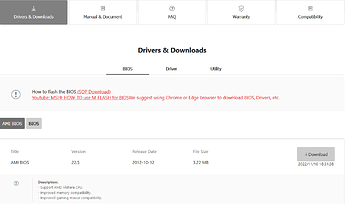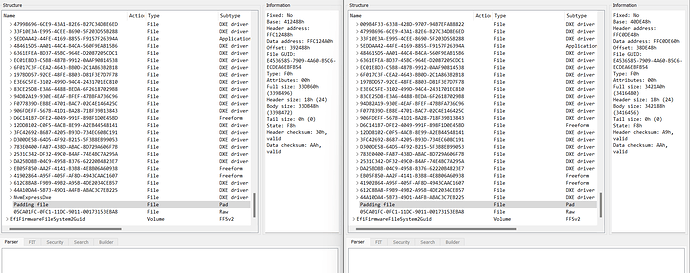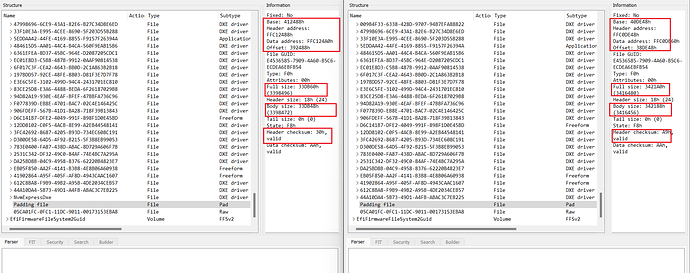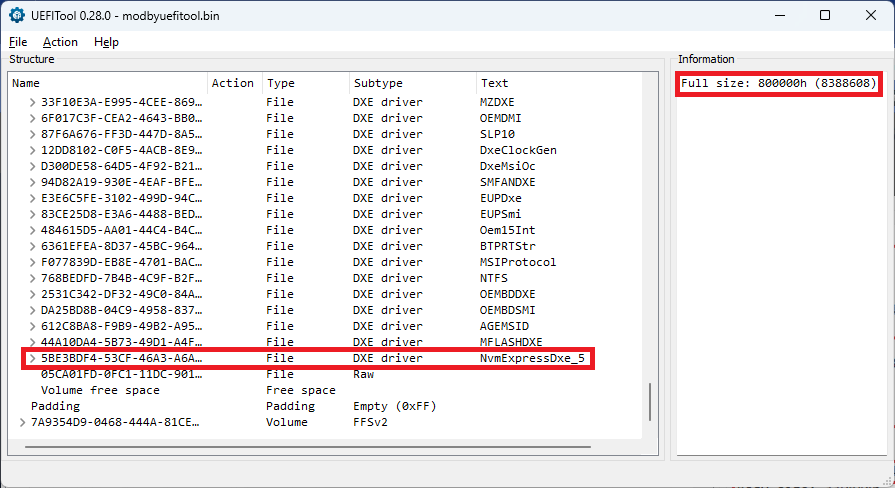You are again wrong. The MMTool I recommend within my guide is the v4.50.023 one.
@Fernando ok I was wrong about you recommending mmtool_v5.007
“Please open the MSI Support link you had posted previously and show me version 23.2.
I don’t want to waste my time for users, who present misleading information.”
I don’t understand why you are on my case like this? Is this how you treat users all the time? do you want more proof that the bios is on the msi website?
I made an account to get help regarding this bios and guide and here you are calling me a user who presents misleading information. You even questioned if I have inserted the NvmExpress_Dxe_5.ffs module.
I have good intentions and am trying to get help on the bios matter.
@MeatWar Thank you will try MMTool 4.X
I used UEFI tool but it destroyed the Padding file unfortunately, tried multiple versions of the tool but no luck
@Alexis
Attached is the screenshot everyone gets after having opened >this< link you had posted:
As you can see, the newest offered AMI BIOS is v22.5. You should have mentioned, that MSI has listed newer BIOS versions not as AMI ones.
I said: “Hello, I have the 990XAGD55 motherboard with bios AMI BIOS 23.2”
well I am a new user, didn’t know I had to mention that, I thought a link to the bios page and the version I used is all it matters to find the bios file. 23.2 is a AMI BIOS
I used MMTool 4.50.0.23 but it modifies the padding:
MMTool 5.02_patched also modified the padding
@Alexis
I am sorry about having called you a user who has presented misleading information. In case of the “missing” BIOS v23.2 it was the MSI Support site, which gave me misleading information. On the other hand I would have spent less time searching for the BIOS, if you would have written, that the v23.2 BIOS is not listed within the “AMI BIOS” section and that I have to click onto the “BIOS” button.
I don’t see any modification of the Pad-file by the MMTool. It is still listed beyond the undermost listed DXE driver.
Maybe you were irritated by the fact, that the inserted NVMe module is still listed above the Pad-file. The module beyond the Pad-file is marked as “Raw”, which means, that it is not a DXE driver.
So I think, that you can flash the modded BIOS, although I don’t overtake any warrenty, that the modded BIOS will work properly.
I used UEFI tool to see the padding file.
I am no specialist that is why I signed up to this forum, the highlighted parts in the modified bios and the original bios I think are different that is why I am having doubts about if I should use the modified bios
@Alexis
Who gave you the advice to use an NE Alpha version of the UEFITool with the detailed Information on the right side, which are only designed for BIOS modding experts? My guide recommends to use one of the latest final UEFITool versions (0.28.0 or 0.26.0), where the content of the right tab looks like this:
If you want more security, please attach or add links to the “pure” original (no *.exe) and your modded BIOS. Then I can do a deeper look into both of them.
@Fernando
bios.rar (7.5 MB)
E7640AMS.N20 original bios from pc
nvmedx5.fd modded bios using MMTool 4.50.0.23
@Alexis
After having checked both BIOSes, I can give you the information, that your modded BIOS is ready for being flashed - no Pad-file has been altered.
By the way - we both would have saved a lot of time, if you would have strictly followed my guide.
Good luck!
@Alexis
Thanks for your feedback.
Let me explain the reason for your comfusion:
The DXE Driver Volume of a BIOS is always compressed, but its total size must not be touched by the BIOS modification.
Consequence: The insertion of any DXE driver module has to be compensated by a stronger compression of all other modules, which are inside the DXE Driver Volume. That is why the sizes and checksums, which are shown by the NE Alpha UEFITool, have been changed after having completed the NVMe module insertion.
I mean, I’m okay with it if you want to give it a spin. It’s been working fine for me.
Edit by Fernando: Tagged for kawaii15 to get him/her notified about the reply
@Fernando Hi, I’ve read a lot of your guides about the bios mod to insert the nvme dxe on old PCs, I think I’ve done everything right, you could check my bios for safety and on asus motherboards I didn’t quite understand what to use to flash the changed bios, I used uefi tool directly, searching and then inserting the file after the last pad, I don’t quite understand this capsule for asus thanks in advance.
@acidburn87
Welcome to the Win-RAID Forum!
Where are your modded and the original BIOS? I can’t see them.
Regarding your question about how to flash a modded ASUS mainboard BIOS please read the start post of >this< thread and post your additional questions there.
Good luck!
Dieter (alias Fernando)
The bios link is here
I read the flash part but I’m not sure I understood correctly if I have to use afudos or Intel Flash Programming Tool, and also the encapsulation maybe I’m wrong these are the 2 things I didn’t understand well forgive me
@acidburn87
Your modded *.ROM file seems to be fine.
Regarding the flashing procedure please post your questions into the appropriate thread (linked within my last post).
ok and thanks for checking, so please confirm that the correct procedure is to open the .cap file and edit it and when it is saved in .rom there is no need to make it go back to .cap correct?
ok for the flash procedure I’m going to the discussion you reported and thank you very much
Hello! Where would I obtain a EFI NVMe module file for my P8P67 Pro Rev3.1 3602 mobo?
Read it… you’ll find it…
EDIT: Yes my friend, you should… you cant miss it because its like this:
This is what you will need:
lol… i need…this is what you will need, simple humm
So careful and to READ: [Guide] How to flash a modded AMI UEFI BIOS - BIOS/UEFI Modding / BIOS Modding Guides and Problems - Win-Raid Forum (level1techs.com)
I’ve read through it a few times. Guess I’m overlooking it. I’ll look again.
Ah. It didn’t stand out to me under that section. I see it now. Thanks!
tbf to myself I’ve been reading a lot of forum posts to learn how to do this bios flash.
I’ve never messed with a BIOS before so this is fun and exciting.



